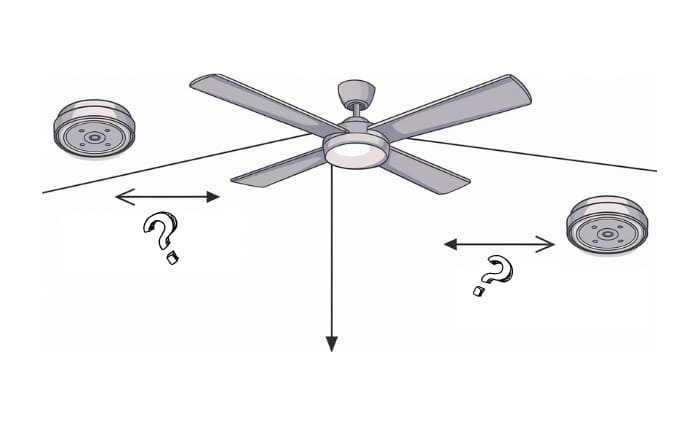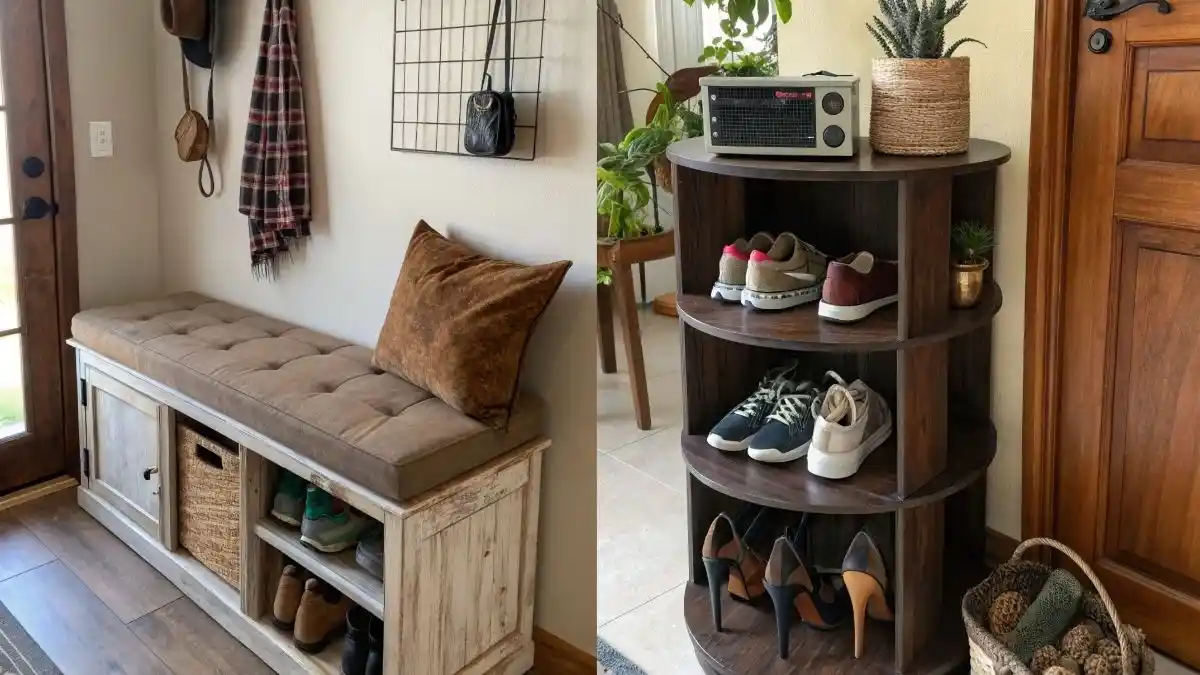Optimal Locations for Installing Smoke Detectors in Bedrooms with Ceiling Fans
So you’re chillin’ in your bedroom, ceiling fan spinning nice and slow—and you suddenly go, wait… where to install smoke detector in bedroom with ceiling fan? Yeah, it’s one of those things we don’t really think about till it matters. But trust me, it really matters. You can’t just stick it anywhere and hope for the best. That fan? It messes with airflow and can delay smoke detection, which ain’t great.
This guide right here breaks it down simple—no fancy talk, just real advice. You’ll learn why placement is super important and where that detector should go so it actually works right. Spoiler: not right next to the fan blades.
And don’t stress, it ain’t rocket science. Just follow a few easy tips, and boom—you’re all set. You get peace of mind and a safer bedroom without wreckin’ the vibe. Ready to know where to install that smoke detector the right way? Let’s go.

WHY SMOKE DETECTORS ARE ESSENTIAL
Okay, so here’s the thing—smoke detectors literally save lives. Like, for real. If a fire breaks out while you're asleep, that little beep could be the only reason you and your fam get out safe. And get this—according to the National Fire Protection Association (yep, they know their stuff), 3 outta 5 fire-related deaths happen in homes that either don’t have smoke alarms or got ones that don’t work. That’s wild, right?
So yeah, having one in your bedroom? Super important. But figuring out where to install smoke detector in bedroom with ceiling fan? That’s where things get a little tricky. But no stress—we got you covered.
UNDERSTANDING THE BASIC FUNCTIONALITY OF SMOKE DETECTORS
Smoke detectors ain’t complicated, but they do work in different ways. Basically, they sniff out smoke or changes in the air and scream at you when stuff goes wrong (literally). There’s two main types:
-
Ionization Smoke Detectors – These ones are better at catching fast, blazing fires.
-
Photoelectric Smoke Detectors – These are more chill and catch the slow, smoky fires.
Both are good. But guess what? Even the fanciest smoke detector won’t help if you slap it in the wrong spot. Especially when there’s a ceiling fan spinning overhead.
THE IMPACT OF CEILING FANS ON SMOKE DETECTORS
Alright, so ceiling fans are cool (pun intended), but they kinda mess with smoke detectors. See, fans move air around. That might sound harmless, but it can actually push smoke away from the detector—meaning it might not go off when it should. So yeah, if you’re asking where to install smoke detector in bedroom with ceiling fan, you really gotta think it through.
NFPA GUIDELINES FOR INSTALLING SMOKE DETECTORS
The NFPA’s got some solid rules for where to stick these things:
-
Inside Bedrooms – Always. No excuses.
-
Right Outside Bedrooms – Like, in the hallway. Fires don’t care about doors.
-
On Every Floor – Even basements. Fires don’t discriminate.
-
Avoid Dead Air Zones – That’s like corners or spots where air just… hangs out.
But ceiling fans? That’s a whole extra level.
OPTIMAL LOCATIONS FOR SMOKE DETECTORS IN BEDROOMS WITH CEILING FANS
DISTANCE FROM CEILING FAN
Big tip here: keep the smoke detector at least 3 feet away from the fan. That’s the sweet spot. Too close, and the air current might mess it up.
PLACEMENT ON WALLS OR CEILINGS
You got two choices—ceiling or wall. But it’s not just a random pick.
CEILING INSTALLATION
-
Stay Out the Swirl – Don’t put it where the fan blades are pushin’ air the hardest.
-
Go Central-ish – Aim for the center of the room, but again, not in direct airflow.
WALL INSTALLATION
-
Height Matters – Mount it like 4–12 inches down from the ceiling. Smoke rises, so don’t go low.
-
Avoid Corners – Smoke likes to chill in open air, not tight corners.
CEILING SLOPES
Got sloped ceilings? No worries. Mount it near the top point, but still within 3 feet of the peak. That way, it catches smoke that floats up.
DUAL INSTALLATIONS
Wanna go the extra mile? Some folks do one on the ceiling and one on the wall. That way, if the fan messes with one, the other’s got your back.
So yeah, figuring out where to install smoke detector in bedroom with ceiling fan ain’t just about slapping it anywhere. It’s about keeping your people safe. Do it smart, sleep better.
Table of Ideal Placement
| Installation Type | Ideal Placement Details |
|---|---|
| Ceiling-Mounted | At least 3 feet away from the ceiling fan blades, outside the blade swirl |
| Wall-Mounted | 4-12 inches from the ceiling, away from corners |
| Sloped Ceilings | Near the highest point, but within 3 feet of the ceiling |
| Dual Installations | Combining both ceiling and wall mounted detectors |
TYPES OF SMOKE DETECTORS SUITABLE FOR BEDROOMS WITH CEILING FANS
PHOTOELECTRIC DETECTORS
So, if you’re wondering where to install smoke detector in bedroom with ceiling fan, lemme tell ya — photoelectric ones are kinda the MVP here. They ain’t too bothered by the wind from your fan and are great at picking up slow, smoldery fires. You know, the kind that sneak up on you when you’re passed out dreaming about brunch.
DUAL-SENSOR DETECTORS
Now if you’re like me and don’t wanna choose, dual-sensor detectors got your back. They mix ionization and photoelectric tech in one lil gadget. Pretty neat, right? So whether it’s a fast blaze or a lazy smolder, you get the heads-up early either way.
SMART SMOKE DETECTORS
Oh, and don’t sleep on smart detectors! These babies send alerts straight to your phone. No more guessing if you left the toaster on. Plus, they’re fancy enough to adjust to how the air moves around — yep, even if there’s a ceiling fan twirling away in your room.
INSTALLATION BEST PRACTICES
PROFESSIONAL INSTALLATION
Sure, slappin’ a detector on the ceiling sounds easy, but pros really know where to install smoke detector in bedroom with ceiling fan the right way. They look at how the air’s moving, especially with that fan goin’, and make sure your detector ain’t just sittin’ pretty but actually workin’ right.
REGULAR TESTING AND MAINTENANCE
Look, it ain’t hard — press that test button once a month. Replace the battery once a year (your future self will thank you), and chuck the whole thing out every 10 years. Trust me, old detectors ain’t cute or helpful.
AVOIDING FALSE ALARMS
Nothing’s worse than a fire alarm goin’ off while you’re frying bacon or takin’ a steamy shower. Keep that detector away from kitchens and bathrooms, especially if your bedroom’s nearby. Steam and smoke are not your detector’s friends.
INTERCONNECTED SYSTEMS
Here’s a safety tip that’s a game-changer: interconnected detectors. When one goes off, they all do. So no matter where the fire’s at, you’ll know. It’s like group chat, but for saving lives.
IMPORTANCE OF COMPLIANCE WITH LOCAL BUILDING CODES
I get it — codes sound boring. But local building codes matter, seriously. They’re like the rulebook for safety. And most of ‘em follow NFPA guidelines, but also throw in stuff specific to where you live. Ignore them, and you might mess things up (or worse, get fined).
COMMON MISTAKES TO AVOID
TOO CLOSE TO AIR VENTS
Repeat after me: don’t install your smoke detector right next to an air vent. Or under your ceiling fan blades. Airflow can shove smoke away from the sensor. And if it don’t catch the smoke, well… that’s kinda the whole point, right?
POOR MAINTENANCE
If you forget to test or replace batteries, it’s basically a useless plastic disc on your ceiling. A dead smoke detector’s just decor. Not the good kind either.
IGNORING CEILING FANS’ IMPACT
This is a biggie. The breeze from your fan can totally throw off the smoke flow. That means the detector might not “see” the smoke in time. So yeah, when you’re figuring out where to install smoke detector in bedroom with ceiling fan, make sure it’s not directly in the airflow.
FUTURE-PROOFING YOUR SMOKE DETECTOR INSTALLATION
UPGRADING TO COMBINATION DETECTORS
Want to level up? Get a combo detector — smoke + carbon monoxide in one. It saves space and might literally save your life. Two threats, one solution. Easy.
INTEGRATION WITH HOME AUTOMATION
If you’re into smart homes and gadgets, hook that detector up to your system. It’ll message you if anything’s up, even if you’re out. Bonus: you get to act all high-tech.
RENEWABLE ENERGY OPTIONS
Ugh, changing batteries is the worst. Some detectors now have lithium ones that last like 10 years. Some even do solar! Save the planet and skip battery runs? Yes, please.
FAQS ABOUT SMOKE DETECTORS IN BEDROOMS WITH CEILING FANS
CAN I INSTALL A SMOKE DETECTOR DIRECTLY ABOVE A CEILING FAN?
Nope. Big no. The fan pushes smoke away, so your detector might miss it. That’s a disaster waitin’ to happen.
HOW OFTEN SHOULD I TEST MY SMOKE DETECTORS?
Monthly. Just do it. Takes like 10 seconds. And swap the batteries once a year.
ARE THERE SPECIFIC SMOKE DETECTORS DESIGNED TO WORK IN ROOMS WITH CEILING FANS?
Not exactly “fan-only” ones, but yeah, photoelectric and smart detectors handle airflow way better.
CAN I INSTALL MULTIPLE SMOKE DETECTORS IN A SINGLE BEDROOM?
Totally. If your room’s huge or has high ceilings, why not double up? Wall mount one, ceiling mount the other — just not in direct airflow.
WHAT SHOULD I DO IF MY SMOKE DETECTOR FREQUENTLY GOES OFF WITHOUT REASON?
Check where you put it. If it’s near a vent, fan, bathroom, or kitchen — move it. It’s probably pickin’ up more steam than smoke.
CONCLUSION
So yeah, figuring out where to install smoke detector in bedroom with ceiling fan ain’t as simple as “stick it on the ceiling and call it a day.” You gotta think airflow, maintenance, and good tech. Choose the right type, avoid rookie mistakes, and keep those batteries fresh.
Peace of mind? Totally worth it. A lil bit of effort now means you’ll sleep better later. And isn’t that what a safe home’s all about?









